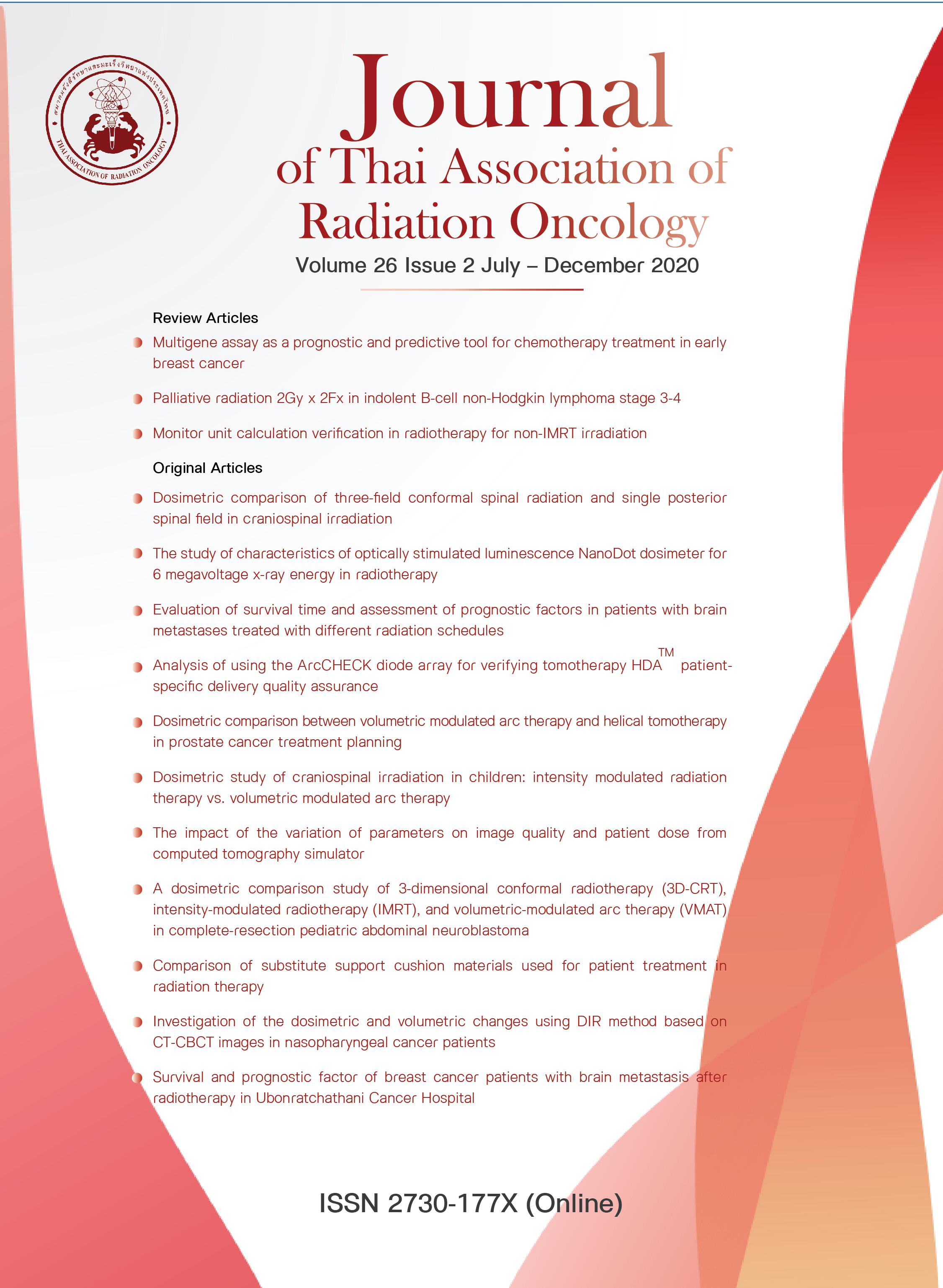The study of characteristic of optically stimulated luminescence NanoDot dosimeter for 6 megavoltage x-ray energy in radiotherapy
Keywords:
radiation dosimeter, OSL, NanoDot, radiotherapyAbstract
Background: Radiation therapy uses high energy photon beams to damage cancer cell. Dose verification is an important step to ensure that dose delivered to patient is accurate. Optically stimulated luminescence dosimeters (OSL) NanoDot has been used for beam dosimetry. The study of dosimetric characteristic of OSL NanoDot is necessary before using it for clinical practice.
Objective: To evaluate the performance of the OSL NanoDot for 6 MV photon beams.
Materials and Methods: Measurements were carried out with OSL nanoDot (Landauer Inc., Glenwood, IL, USA) using 6 MV photon beam to evaluate the dosimetric characteristic such as fading characteristics, reproducibility, signal depletion per read out, angular dependence, dose linearity, dose rate dependence and source to surface distance dependence. Measurements were performed with source axis distance (SAD) and source to surface distance (SSD) technique. The experimental set-up and dose parameter were according to the clinical practice. After irradiation, induvial OSL NanoDots were read out and repeated at least five times and the values were averaged.
Results: The fading result of NanoDot showed more than 15% signal loss after irradiation then. The signal is stable after five minutes after irradiation. The reproducibility ± 2.5% and signal depletion per read out 0.05% signal per read out. The detector exhibited linearity with the R2 of 0.9991. The angular dependency when the beam was irradiated perpendicular to the detector. NanoDot is independence with dose rate. However, the signal was decreased when increased the source to surface distance.
Conclusions: The detector properties must be studied by the user before apply in dose verification for accurate determination of the entire dose on the patient. The investigation possible lead to excellent treatment quality and prevention of any dose errors.
References
โรงพยาบาลจุฬาลงกรณ์. หลักการรักษาด้วยรังสี. [cited 2020 10 march]; Available from: https://www.chulacancer.net/patient-list-page.php?id=420.
Agazaryan N. Patient specific quality assurance for the delivery of intensity modulated radiotherapy. Journal of Applied Clinical Medical Physics. 2003;4(1):40.
Son J, Baek T, Lee B, Shin D, Park SY, Park J, et al. A comparison of the quality assurance of four dosimetric tools for intensity modulated radiation therapy. Radiology and oncology. 2015 Sep;49(3):307-313.
Spezi E, Angelini AL, Romani F, Ferri A. Characterization of a 2D ion chamber array for the verification of radiotherapy treatments. Physics in medicine and biology. 2005 Jul 21;50(14):3361-3373.
Campajola L, Casolaro P, Capua FD. Absolute dose calibration of EBT3 Gafchromic films. Journal of Instrumentation. 2017;12(08):P08015-P.
Devic S, Tomic N, Lewis D. Reference radiochromic film dosimetry: Review of technical aspects. Physica medica : PM : an international journal devoted to the applications of physics to medicine and biology : official journal of the Italian Association of Biomedical Physics. 2016 Apr;32(4):541-556.
Syam Kumar SA, Sukumar P, Sriram P, Rajasekaran D, Aketi S, Vivekanandan N. A patient-specific quality assurance study on absolute dose verification using ionization chambers of different volumes in RapidArc treatments. Medical dosimetry : official journal of the American Association of Medical Dosimetrists. 2012 Winter;37(4):436-441.
Carlino A, Stock M, Zagler N, Marrale M, Osorio J, Vatnitsky S, et al. Characterization of PTW-31015 PinPoint ionization chambers in photon and proton beams. Physics in medicine and biology. 2018 Sep 19;63(18):185020.
Low DA, Parikh P, Dempsey JF, Wahab S, Huq S. Ionization chamber volume averaging effects in dynamic intensity modulated radiation therapy beams. Medical physics. 2003 Jul;30(7):1706-1711.
ศุภวิทู สุขเพ็ง. เครื่องมือวัดปริมาณรังสีเอกซ์: สำนักพิมพ์มหาวิทยาลัยนเรศวร; 2016:67 - 91.
Alvarez P, Kry SF, Stingo F, Followill D. TLD and OSLD dosimetry systems for remote audits of radiotherapy external beam calibration. Radiat Meas. 2017 Nov;106:412-425.
จินดา ทองเรือง สิริชัย, เธียรรัตนกุล และวีรชัย ดิสวัฒน์ .คุณลักษณะของอุปกรณ์วัดรังสีโอเอสแอล ชนิดนาโนดอท สำหรับงานรังสีวินิจฉัย. กรมวิทยาศาสตร์การแพทย์. 2016;158(3):141-148.
Landauer N. OSL Dosimeters. [cited 2020 10 march]; Available from: https://www.nagase-landauer.co.jp/english/inlight/dosimeters.html.
Dunn L, Lye J, Kenny J, Lehmann J, Williams I, Kron T. Commissioning of optically stimulated luminescence dosimeters for use in radiotherapy. Radiation Measurements. 2013;51-52:31-39.
Jain GK, Chougule A, Kaliyamoorthy A, Akula SK. Study of dosimetric characteristics of a commercial optically stimulated luminescence system. Journal of Radiotherapy in Practice. 2017;16(4):461-475.
Jursinic PA. Characterization of optically stimulated luminescent dosimeters, OSLDs, for clinical dosimetric measurements. Medical physics. 2007 Dec;34(12):4594-4604.
Ponmalar R, Manickam R, Ganesh KM, Saminathan S, Raman A, Godson HF. Dosimetric characterization of optically stimulated luminescence dosimeter with therapeutic photon beams for use in clinical radiotherapy measurements. Journal of cancer research and therapeutics. 2017 Apr-Jun;13(2):304-312.
Viamonte A, da Rosa LA, Buckley LA, Cherpak A, Cygler JE. Radiotherapy dosimetry using a commercial OSL system. Medical physics. 2008 Apr;35(4):1261-1276.
Downloads
Published
How to Cite
Issue
Section
License
บทความที่ได้รับการตีพิมพ์เป็นลิขสิทธิ์ของวารสารมะเร็งวิวัฒน์ ข้อความที่ปรากฏในบทความแต่ละเรื่องในวารสารวิชาการเล่มนี้เป็นความคิดเห็นส่วนตัวของผู้เขียนแต่ละท่านไม่เกี่ยวข้องกับ และบุคคลากรท่านอื่น ๆ ใน สมาคมฯ แต่อย่างใด ความรับผิดชอบองค์ประกอบทั้งหมดของบทความแต่ละเรื่องเป็นของผู้เขียนแต่ละท่าน หากมีความผิดพลาดใดๆ ผู้เขียนแต่ละท่านจะรับผิดชอบบทความของตนเองแต่ผู้เดียว




